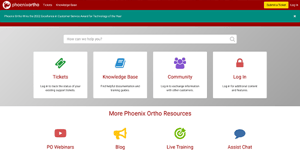Durable medical equipment (DME), defined by Healthcare.gov as “Equipment and supplies ordered by a health care provider for everyday or extended use,” is a mainstay for orthopedic clinics. From crutches to casts, wheelchairs, braces, and more, the list of durable medical equipment used by orthopedists is extensive.
Keeping track of DME medical equipment codes, inventory levels, and how frequently specific pieces of equipment are used can be an enormous task for any orthopedic practice. However, staying on top of DME inventory management challenges is vital for avoiding shortages of crucial equipment patients may need (or overstocking and wasting money on unnecessary inventory).
What are the challenges of managing DME inventory? How can using DME software benefit orthopedic clinics? Where can orthopedic practices find reliable DME software vendors?
DME Inventory Management Challenges
Some of the key DME inventory management challenges that orthopedic clinics face include:
1) Keeping Track of DME Medical Equipment Codes
Having the right medical equipment codes assigned to DME inventory is a must for filing claims with Medicare and other health insurance providers. Keeping up to date with any changes in medical equipment codes to avoid applying the wrong codes can be crucial for preventing claims rejections.
2) Tracking Inventory Usage Rates
How frequently does the practice give out specific types of durable medical equipment? Knowing how many wheelchairs, crutches, and other pieces of DME are used each day is vital for ordering the right amount of replacement inventory to avoid shortages.
3) Tracing Inventory Lots for Recalls
Occasionally, a particular medical equipment product or shipment might have issues that require a recall. For example, a production lot might have become contaminated or have manufacturing quality issues that make the equipment unsafe. Being able to track which pieces of DME are part of that recall can help improve safety and allow orthopedic practices to notify their patients about potential safety issues (and make replacing potentially dangerous DME easier).
4) Managing DME Inventory Storage
A major DME inventory management issue is the storage and retrieval of medical equipment. While some practices may be able to keep their DME inventory in a small space without worry, practices that need to manage a large variety or high amount of DME simultaneously may struggle with storage and retrieval.
5) Preventing DME Inventory Shrink
Inventory shrinkage, or the loss of inventory due to theft by employees or customers, is just as much of a problem for healthcare practices as it is for retail stores. For example, near the beginning of the Coronavirus pandemic, CNBC and other sources reported that “people have started to steal masks and other medical equipment from local hospitals.” Keeping track of DME inventory and preventing shrink is vital for preventing equipment shortages and avoiding excess spending on replacing stolen items.
Failing to effectively manage DME can lead to wasted time and money, make it harder for physicians to treat patients, and negatively impact patient satisfaction if getting them the equipment they need takes too long because something is on backorder or isn’t available.
This is where having DME software can help.
Benefits of DME Inventory Management Software
How can DME software help orthopedic clinics overcome their DME inventory management challenges? Here are a few of the benefits of having DME software to help with inventory management:
1) Always Knowing What Supplies Are Available
With inventory management software and the ability to log each piece of DME as it is added to or removed from the inventory, keeping track of which pieces of equipment are on hand is simple. Some DME software provide a simple chart with a list of durable medical equipment to give an at-a-glance view of which types of DME they have on hand and how much is available.
2) Setting up Low Inventory Alerts
Some DME software can generate reminders for whoever is in charge of ordering inventory whenever the stock of specific pieces of DME hits a critical low. Customizing these reminders to accommodate for standard delays between an order and receiving the product can help orthopedists avoid running out of important DME supplies.
3) Tracking Inventory Usage Rates
Using data recorded by a DME software, orthopedic clinic managers can identify which doctors are frequently prescribing specific types of equipment and how much DME inventory is being used per week.
This information can be useful for:
- Identifying usage of medical equipment (possibly helping to stop inventory shrinkage)
- Estimating the budget needed for DME inventory (helping the practice better balance its budget for healthier cash flow).
4) Reducing the Risk of Over-or Under-Ordering Supplies
Ordering too much durable medical equipment at once wastes money that could be better spent on other clinic operations. On the other hand, ordering too little DME can lead to shortages that leave the clinic unable to satisfy its patients’ needs (negatively impacting satisfaction). DME software makes it easy to track overall inventory and usage rates so the clinic can order only what it needs without unnecessarily increasing the risk to equipment shortages.
5) Improving Traceability for DME Inventory
If there’s a product recall for any DME that the practice is using, it may be helpful to know exactly which pieces of equipment are part of the recall. By tracking when certain pieces of equipment arrived, it’s easier to identify which items are part of the recall (if it’s limited to a specific production lot). This, in turn, helps orthopedic clinics minimize the impact of such recalls—instead of having to send back every piece of equipment of a certain type, they can send back only the affected items.
6) Preventing Inventory Shrinkage
With an increased ability to track specific pieces of DME and being able to track unusual use patterns (such as physicians not normally known to prescribe the use of DME suddenly ordering it for patients not needing it), it becomes easier to identify and prevent the theft of medical equipment.
Looking for a reliable DME software for your orthopedic practice? Finding good DME software vendors can be tough. However, users of Phoenix Ortho’s EHR software suite are in luck. Phoenix Ortho has a DME inventory management solution that allow users to easily track inventory levels and receive alerts when inventory is low.
Are you ready to simplify your orthopedic practice management? Reach out to the Phoenix Ortho team today to discover how you can save time, money, and mouse clicks on everyday orthopedic workflows!
Schedule a 1:1
Get in touch with Phoenix Ortho to learn more about how you can save time, money, and mouse clicks with an orthopedic-specific EHR.






















